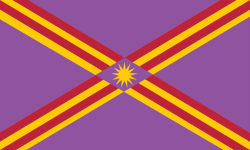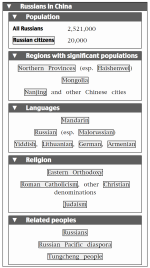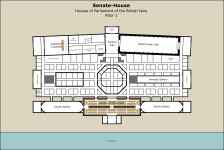
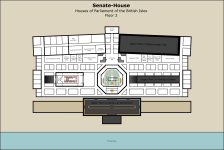
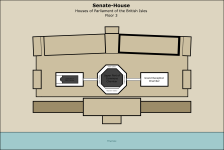
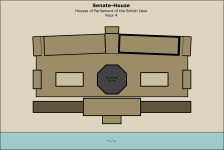
The
Senate-House, often known as the
Houses of Parliament, is the seat of the Parliament of the British Isles, located in its capital of London. While this site has been used for various Parliaments for eight hundred years, it was held in the old Palace of Westminster until its destruction in the Orange Riots of 1834; the Senate-House was constructed from 1838 to 1853 on its ruins, and only one of its rooms, Westminster Hall, is a continuation of the old Palace of Westminster. Constructed in an austere neoclassicalism evocative of the Roman Republic that the British Isles has, since even before the Popular Revolution, sought to evoke, the Senate-House and its iconic octagonal dome is today a great British landmark.
Westminster Hall
The first Westminster Hall was constructed in 1097 by King William Rufus, son and successor of the infamous William the Conqueror. On the model of the contemporary trend of great halls for royal banquets, it was far larger than any of them, and in practice kings used side-halls for that purpose. Instead, the Hall was used to host judicial inquiries. It got its iconic hammerbeam roof in 1393, and over the following centuries Westminster Hall was used for meetings, petitions, inaugurations of Parliament, impeachments, and one royal execution. The last grand event held in this old Westminster Hall was immediately after the Popular Revolution, with the 1829 promulgation of the Charter and Frame into law by Chief Magistrate Lord Holland.
This Westminster Hall no longer exists, however. In 1834 in the wake of the Municipal Reform Act which tore to shreds traditional municipal government, an Orange Order mob gathered in the yard just outside Westminster Hall. To book their hatred of the post-revolutionary regime and loyalty to the Guelphs, this mob sought to storm Westminster Hall - and they did, by ripping apart its doors. Armed with torches - and a few with gunpowder bombs, it did not take long for the mob to ignite Westminster Hall's wood roof. This swiftly forced them to hastily flee - many by punching holes in the Hall - and most of them fled the premises. The fire this ignited proved to be total - the fire department too busy putting out fires ignited by Orange mobs across the city, and an Orange mob just outside the fire was intent on seeing the palace burn to the ground - hopefully with the republican traitors of Parliament inside. By the time Lord Holland had gathered Parliament at Exeter Hall and secured its approval to use the army against the Orange mobs, Parliament had been almost entirely burned to the ground. Westminster Hall in particular had its roof collapse in on itself, leaving it a hollow husk of broken walls.
In truth, Parliament had planned on leaving this site. An 1833 resolution on the subject saw overwhelming approval for relocating Parliament for new premises in Green Park and leaving only the courts to the old, decaying Palace of Westminster. But after this fire, it was unthinkable. The old, Gothic palace had burned down, and the site had now become national honor; to relocate would be to surrender to the Orange mob. And the vacated space offered room for a new, modern senate-house befitting the revolutionary order. But while Parliament had little nostalgia for the old palace, Westminster Hall was too august a place to leave behind in the past. And so, the contest for new parliament buildings had only one parliament - there needed to be a reconstructed Westminster Hall. The approved plan saw, on the outside, Westminster Hall made of marble, and it was given a copper roof. But though the pointed roof was somewhat lower, on the inside the Hall was a near replica of the old one, including its Gothic hammerbeam ceiling. However, a neoclassical facade was added to its entrance, and its window was replaced with a painting depicting the ratification of the Charter of Liberty and Security and Frame of Government, to represent the new constitutional order. In 1847, Westminster Hall saw it go back to usual business with the lying of state of the great Daniel O'Connell.
Additionally, Westminster Hall became a memorial hall - in honor of the British tradition of liberty. On the walls, beneath the ribs of the roof, were installed statues of various icons of British liberty:
1. Robert Fitzwalter, leader of the baronial opposition to King John and whose victory secured the Magna Carta
2. Simon de Montfort, baron who convened a parliament which included, for the first time, full representatives of the Commons
3. William Wallace, Scottish knight who fought an English invasion that sought to incorporate it without its consent
4. John Fortescue, statesman during the War of the Two Roses who recognized the supremacy of Parliament in the Constitution
5. Edward Coke, judge and politician who opposed Charles I's absolutism, challenged the Star Chamber's tyranny, and was the moving force of the Petition of Right
6. John Hampden, who opposed Charles I's unconstitutional levy of Ship Money, resisted arrest as one of the Five Members, and died in battle in the early stage of the Puritan Revolution
7. John Pym, who defeated Stuart schemes through parliamentary procedure, resisted arrest as one of the Five Members, and organized the war effort of the early Puritan Revolution
8. Harry Vane, who opposed both Stuart and Cromwell, fought for religious liberty, and suffered executed following the Restoration
9. William, Lord Russell, Whig politician who opposed the Stuarts during the Restoration and martyred for it
10. Algernon Sidney, theorist of republicanism who opposed both Stuart and Cromwell, and executed for opposing the Stuart king Charles II
11. John Somers, Baron Somers, who opposed the Stuart king James II, was a moving force in the Glorious Revolution, and framed the Bill of Rights
12. John Locke, Whig theorist and philosopher whose ideas lie at the heart of classical radicalism and republicanism
13. Isaac Newton, mathematician and physicist who first developed calculus and formulated Newtonian classical mechanics and optics
14. Benjamin Franklin, American scientist and revolutionary who discovered the principles of electricity and the nature of lightning and became a moving force of the American revolutionary movement
15. George Washington, who defeated the forces of the Guelph king George III in the American Revolution and became the first President of the United States
16. Charles Pratt, Earl Camden, judge and politician who upheld habeas corpus, supported the American Revolution, and protected the rights of juries
17. Richard Price, Welsh mathematician and radical reformer who condemned religious disabilities and daringly praised the French Revolution as a heroic product of the great British tradition of liberty
18. Thomas Muir, Scottish radical reformer who suffered deportation for his political beliefs and returned to die in a republican rebellion
19. Edmund Burke, founder of moderatism who praised the American Revolution, advocated Catholic emancipation, opposed British atrocities in India, and attacked the French Revolution
20. Mary Wollstonecraft, philosopher, author, and founder of the women's rights movement
21. Lord Edward Fitzgerald, Irish revolutionary republican who served as Executive Councillor for the Interior for the declared Irish Republic during the Great Irish Rebellion (1796-9) in the name of religious unity
22. Charles James Fox, who supported the American and French Revolutions, opposed the power of the Crown, pushed parliamentary reform, and whose values saw vindication in the Popular Revolution
23. Richard Brinsley Sheridan, famed Irish playwright and politician who led the Foxite party after the death of Charles James Fox
24. Samuel Whitbread, radical Foxite, imprisoned in the Tower of London and freed by the mob in the Popular Revolution, and became the first Radical prime minister and faced the Orange Riots
25. Daniel O'Connell, who fought for civil and religious liberty through peaceful protest and secured the formation of the Irish Legislature
26. Henry Brougham, who in the wake of the Popular Revolution reformed and codified criminal, commercial, prodecural, and civil law
This has been for the most part consistent with one exception - a statue of Oliver Cromwell was replaced with Wollstonecraft in 1959.
Additionally, between the statues, were installed paintings of:
1. Boadicea addressing her troops before her tragic defeat (61 AD)
2. Alfred and the Witenagemot instituting trial by jury (878 AD)
3. King John reluctantly signing the Magna Carta (1215)
4. Simon de Montfort summoning a Parliament including the Commons (1265)
5. Peter de la Mare presiding as the Commons' first speaker (1376)
6. Peter Wentworth in the Tower of London for exercising freedom of speech in the Commons (1576)
7. Edward Coke confirming the supremacy of Parliament through the Case of Proclamations (1611)
8. Charles I forced to give assent to the Petition of Right (1628)
9. William Lenthall refusing to tell Charles I the location of the Five Members (1642)
10. John Hampden's martyrdom for the Parliamentary cause at Chalgrove Field (1643)
11. Algernon Sidney writing his
Apology in the Day of his Death awaiting execution (1683)
12. William III accepting the Declaration of Right (1688)
13. Signing of the American Declaration of Independence (1776)
14. The vote of no confidence against Lord North's ministry (1782)
15. Edmund Burke's opening of the impeachment of Warren Hastings (1788)
16. Charles James Fox toasting to the sovereignty of the people (1798)
17. Charles James Fox's release from the Tower of London (1801)
18. Daniel O'Connell advocating against the Dissenting Ministers Act (1813)
19. Protests immediately before the Manchester Massacre (1819)
20. Samuel Whitbread toasting to the Majesty of the People (1825)
21. Protests immediately before the Clontarf Massacre (1826)
22. The Rump Privy Council convening a Convention Parliament (1827)
23. Parliament meeting at Exeter Hall despite Orange Order violence (1834)
24. Henry Brougham presenting his Civil Code to Parliament (1843)
Westminster Hall is today used for various purposes beyond being a memorial hall. It is used for openings of Parliament, convenings of the High Court for the Trial of Impeachment, meetings and presenting of petitions, and times when Parliament meets as a Senate for the election of a Chief Magistrate and resolution of Peers-Commons disputes.
Central Hall
The main entrance to Westminster Hall, Central Porch opens to Central Hall, a grand hall which contains entrances to Westminster Hall, the main corridor of the Judicial Quarter, stairs to the second floor, and a corridor to the rooms below the Commons Chamber. Contained with it are four statues, female allegories of liberty, justice, wisdom, and victory.
Judicial Quarter
For the purpose of symmetry, and for the housing of the Supreme Court of Judicature, the new plans saw plans for the creation of a Judicial Quarter on the other side of Westminster Hall. It chiefly consists of a Judicature Chamber and a number of other offices for its various judges and the Justice Minister.
The Judicature Chamber was constructed with a curved ceiling evocative of the Pantheon. In naves behind the, it contains statues of
1. Alfred the Great, Saxon king of England celebrated as a lawgiver
2. Henry de Bracton, English jurist who expounded the principles of old Common Law
3. John Fortescue, English chief justice who recognized the civil liberties of freeborn Britons
4. Edward Coke, English jurist who challenged the brutality of the Star Chamber
5. Oliver Ellsworth, American jurist who co-drafted the American constitution and established its judiciary
6. John Philpot Curran, Irish lawyer who defended the people and suffered execution for his support of the United Irishmen
7. John Erskine, English lawyer who defended radicals and reformers amidst Pitt's Terror
Occasional calls to relocate the Supreme Court of Judicature to a purpose-built building have failed, because it is generally considered that it being located in the same building as Parliament gives it a certain centrality to the nation.
Commons Chamber
While the old Palace of Westminster stored the Commons in a drastically-undersized chamber, the Senate-House instead gave it the central position within its great octagonal dome. To ensure sessions get enough sunlight, the Commons Chamber is located on the second floor, and its dome is high enough it lets in plentiful sunlight in the day through its windows.
The chamber itself consists of levelled benches in a horseshoe layout, a layout intended as a compromise between the opposing benches of the old House and the hemicycle layout of antiquity; both designs could be called scientific from a certain perspective, the former emphasizing intensity of debate, and the latter the unity of the nation. The benches are laid out so they have room for full capacity; in practice, as only a fraction of this meets regularly, the top benches are left empty. Additionally, it contains a special Ministers' Bench for ministers, given a permanent invitation to sit as non-voting MPs; formerly, ministers could be (and were) elected as ordinary MPs, but following the Popular Revolution, to remove the Crown's and Lords' improper influence in the Commons, this was abolished, but to hold them accountable they were incorporated as non-voting MPs. In contrast to the green leather of the rest of the Commons seat, the color of the people, the Ministers' Bench has red leather, the color of the executive, to ensure they cannot blend into the people. Furthermore, the Speaker is an officer of the Commons elected outside its number; in practice, a retired statesman or civil servant is elected to this position, and the Speaker is seated in a chair in the far end, at the center, of the horseshoe. Below the speaker is the Table of the House of Commons, and here sits a Clerk and Legislation Minister to provide aid and advice to the general House. Furthermore, to bring the House into session, the Serjeant-at-Arms, who heads security in the Commons and remainder of the Senate-House.
Behind the Speakers' Chair is an office where the Legislation Minister sits in off-hours. The job of the Legislation Minister is to review bills and propose amendments of style to harmonize them with existing laws and suggest improvements, and to present laws proposed by members of judiciary; additionally, they organizes laws into a law code to be published by the National Gazette, and they try to make sure all laws are consistent with one another. On the upper part, the Chamber contains viewing galleries, with one reserved for reporters for the purpose of public opinion. More recently, phones and cameras have been added to the Reporters' Gallery for the purpose of broadcasting on the phote and the scope.
Above the Speaker's Chair is a standard with the traditional flags of England, Scotland, Wales, and Ireland added at quarters, and above that is a painting of Britannia with Roman armor and holding a shield and pole with a Phrygian cap. Additionally, in naves to the left and right of the painting, are statues of outstanding MPs, namely, John Hampden and Charles James Fox. Additionally, the Chamber is topped with an octagonal dome, and at the top of this dome is a marble statue of Britannia, with a depiction much the same as that above the Speaker's Chair. The Commons Hall, or the entrance to and from the Commons, contains additional statues of two outstanding speakers, namely Peter de la Mare and William Lenthall.
Peers Chamber
The Chamber contains the House of Peers, to the side of the Commons Chamber. Historically, the House of Lords was in a grander chamber than the Commons; in the new Senate-House, it was given a considerably less grand chamber. This was often justified on the basis of it being considerably smaller than the Commons, but has much to do with the considerable anti-Lords sentiment following the Popular Revolution as well as the supremacy of the Commons codified in the new Frame of Government. The Peers Chamber was built with traditional three-way seating, within a long and tall room, and a chair where the Lord Chancellor, who presides over the Peers, sits; formerly, the Lord Chancellor sat on a sack of wool, a legacy of a medieval attempt to promote the wool industry, an absurd thing which got unceremoniously abolished following the destruction of the Palace of Westminster.
It also contains, above the Lord Chancellor's chair, a chair to the Chief Magistrate; once upon a time, the kings who preceded the chief magistrates sat here regularly, but since the House of Lords ceased to be a mere coterie of descendants of the friends of dead kings and became a truly independent body under the republic, it is now vacant except when the Chief Magistrate addresses both houses of Parliament during Annual Speeches to Parliament. Additionally, this chair sits in a semicircular apse, and in this apse, in columns, sits statues of outstanding Peers of old, namely William Murray, Earl of Mansfield; Thomas Erskine, Baron Erskine; and Henry Vassall-Fox, Baron Holland.
Historically, the pre-revolutionary Peers Chamber was decorated with the Armada Tapestries representing the great victory against the Armada Tapestries; these were removed in 1823 by the pre-revolutionary regime to place them in display across the nation, before they got placed into storage following the Revolution and placed in a separate place of honor in the new chamber. Instead, the Peers, packed with good Radicals by that point, commissioned in 1855 tapestries commemorating the triumph of Parliament over the Orange Riots, hanging on the walls of the chamber below the galleries. They consist of:
1. Signing of the Municipal Reform Act
2. Orange Order attacking Parliament
3. Evacuation of the Houses of Parliament
4. Parliament assembled at Exeter Hall in defiance of the mob
Armada Gallery
In 1591, the Lord High Admiral of the English navy commissioned ten tapestries in honor of the great victory over the Spanish Armada. In 1651, the First Commonwealth draped the tapestries in the vacated House of Lords; by the time Charles II took over the British Isles in 1660 and reinstated the House of Lords, this was kept there, symbolic of British power. In 1823, the Guelph government took these tapestries off these walls to tour them across the nation in resistance to a French invasion. By the time the Popular Revolution broke down, an administrator stored them into Windsor Palace for safekeeping, and after the revolution the new government did not have any desire to put them back up on its walls, for the Lords had many loyal to the Guelphs. This, fortuitously, meant the tapestries escaped the Orange Riots and the fire. With the Lords having hardly helped things by the veto of the Municipal Reform Act, blamed for kicking off the Riots in the first place, the new Senate-House contained a special gallery area for displaying the Armada Tapestries. Today, they are placed within glass frames, and they exit to a staircase to the Commons Chamber.
Library of Parliament
The need to create this Library occurred for two reasons. First, the burning of parliamentary records, going back to the thirteenth century, in the fire kicked off by the Orange Riots was widely mourned, and it demonstrated the need for a modern hall of records. Second, the King's Library of George III, a truly colossal library evocative of the Age of Reason stored by later kings, was nationalized following the Popular Revolution, and an oft-stated idea of what to do with it was to make it accessible to Parliament. Following the Orange Riots, plans for a new parliamentary building included room for a library of parliament, and the approved plans included a semi-separated Library of Parliament building, iron-framed for fireproofing, to store both the King's Library and parliamentary records.
The Library of Parliament is today run nominally by the Legislation Minister. It has since grown in such scale that it has an additional building, the Henry Brougham Building, off the premises of Parliament, and it has become the second largest library in the world (second only to the Bibliothèque Nationale). The Old Building contains a massive number of books, however, as well as a repository of records. The Library also contains an additional entrance on the riverside. At the center of the Library is a colossal statue of John Milton, republican hero and the famed author of Paradise Lost, and on its entrance is statues of great authors of British history:
1. William Shakespeare
2. John Dryden
3. Henry Fielding
4. Jonathan Swift
5. Alexander Pope
6. Robert Burns
7. Richard Brinsley Sheridan
8. Walter Scott
Library Galleries
The plans for the new Senate-House also included galleries for displaying documents of liberty. Lavishly decorated with paintings and friezes, it stores documents of the:
1. Magna Carta
2. Petition of Right
3. Grand Remonstrance
4. Act of Habeas Corpus
5. Bill of Rights
6. Toleration Act
7. American Declaration of Independence
8. Charter of Liberty and Security
Notably, the American Declaration of Independence, stores a copy given to the American Revolution-supporting Duke of Richmond and was donated to Parliament by his grandson.
Other Rooms
The Senate-House contains a number of rooms for officers of both Houses of Parliament, including the National Election Office which manages elections to both Houses of Parliament, and the Parliamentary Guard Office which headquarters the Parliamentary Guard which guards the Senate-House, the Henry Brougham Buildings, the Tower of London, and other buildings under the control of Parliament. It also contains a great number of committee rooms. It also contains a sumptuously-decorated Grand Reception Chamber, symmetrical to the upper part of the Peers Chamber, used for purposes such as hosting grand committees and receiving foreign heads of state.








